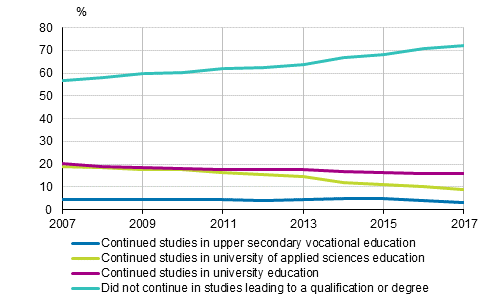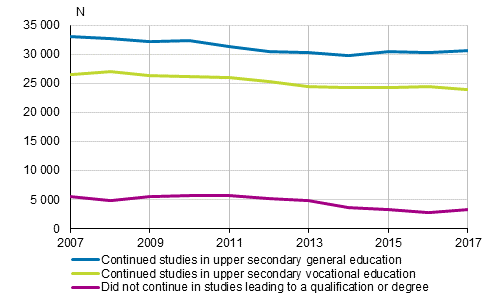Published: 13 December 2018
Only 28 per cent of new passers of the matriculation examination continued studies in the same year
According to Statistics Finland's education statistics, 72 per cent of new passers of the matriculation examination in 2017 did not continue studies leading to a qualification or degree in the year of the matriculation examination. In ten years, the share of those left outside further studies among new passers of the matriculation examination has grown by 15 percentage points. Seventy-five per cent of passers of the matriculation examination applied for further studies. Of completers of comprehensive school, 53 per cent immediately continued in upper secondary general education after comprehensive school and 41 per cent in vocational education.
Immediate transition to further studies of new passers of the examination in 2007 to 2017, %

Nearly 16 per cent of new passers of the matriculation examination in 2017 immediately continued in university education, nine per cent in university of applied sciences education and three per cent in vocational education. Seventy-five per cent of new female passers of the matriculation examination and 68 per cent of male ones remained outside education. Male passers of the matriculation examination continued more often than women in university and university of applied sciences education, 31 per cent of men and 21 per cent of women started tertiary level studies. Two per cent of men and four per cent of women started vocational education in the year of passing the matriculation examination.
Three out of four new passers of the matriculation examination applied to further education in the year of the matriculation examination. Seventy-three per cent of new passers of the matriculation examination in 2017 applied to tertiary education, 75 per cent of women and 72 per cent of men. Forty-two per cent of passers of the matriculation examination applied only to university education and 17 per cent applied only to university of applied sciences education and 14 per cent applied simultaneously to both university of applied sciences and university education. In all, 1.5 per cent of new passers of the matriculation examination applied to upper secondary vocational education.
Many passers of the matriculation examination have a gap year or years before further studies
Immediate continuation of studies among new passers of the matriculation examination has become more difficult than in the year before already for over 10 years. Many new passers of the matriculation examination have to have a gap year or years before finding a place for further studies, even though most apply to further studies right after passing the matriculation examination.
Entrance to education by passers of the matriculation examination in 2014
| Number of gab years |
Completers of the matriculation examination, toltal in 2014 | Studying, % | In Vocational education | % | In Highschool | % | Did not continue studies leading to a qualification or degree 1) | % |
| 1 | 32 060 | 58,2 | 3 222 | 10,0 | 15 456 | 48,2 | 13 382 | 41,7 |
| 2 | 32 060 | 71,3 | 3 104 | 9,7 | 19 739 | 61,5 | 9 217 | 28,7 |
| 3 | 32 060 | 73,9 | 2 093 | 6,5 | 21 610 | 67,4 | 8 357 | 26,1 |
When examining as an example the transition of new passers of the matriculation examination (32,060) in 2014 in further studies by the end of 2015, a place for further studies had been found after one gap year by 58 per cent, nearly one half had started studies in tertiary education and nearly every tenth studied in upper secondary vocational education. Every fifth was working full-time in the year following the matriculation examination. Eight per cent were unemployed and 12 per cent were in some other activity, for example, abroad or in compulsory military or non-military service.
After two gap years most had started further studies. Of the 2014 passers of the matriculation examination, over 71 per cent were studying, 62 per cent in tertiary education and 10 per cent in upper secondary vocational education in 2016. The share of those starting studies after three gap years had grown by 74 per cent.
Fifty-three per cent of completers of the 9th grade of comprehensive school continued studies in upper secondary general school
There were around 57,800 completers of the 9th grade of comprehensive school in 2017. Nearly all completers of the 9th grade of comprehensive school applied immediately to further studies, 0.4 per cent did not do so. Sixty-four per cent of girls applied primarily to upper secondary general school. Of boys, 55 per cent applied primarily to upper secondary vocational education.
Direct continuation to further studies for completers of comprehensive school 2007–2017

Ninety-four per cent of completers of comprehensive school continued in education leading to a qualification. Fifty-three per cent of completers continued in upper secondary general school and 41 per cent in upper secondary vocational education. The share of those continuing in vocational education decreased from the previous year. A total of 1,050 completers of comprehensive school continued in guidance and preparatory education and 500 in additional education of the comprehensive school (10th grade). In all, 1,800 young people stayed outside all the above-mentioned types of education.
Additional education of the comprehensive school (10th grade) and preparatory education ease entrance to education later
When examining those having completed basic education in 2016, who were outside upper secondary general education, vocational education, guidance and preparatory education and additional education of basic education (1,426), either upper secondary general school or vocational education had been started by 61 per cent of them in 2017. Of those having been in the 10th grade, 92 per cent had started in education leading to a qualification after one year, 48 per cent in upper secondary general education and 44 per cent in vocational education. Sixty per cent of those in guidance and preparatory education continued next year in education leading to a qualification, most in vocational education.
Transition to further studies in 2017 of completers of the 9th of comprehensive school in 2016
| 9th of comprehensive school in 2016 |
Total | Studied in upper secondary general education in 2017 | % | Studied in vocational education in 2017 | % | Did not continue studies leading to a qualification or degree | % |
| Total | 57 615 | 29 922 | 51,9 | 25 530 | 44,3 | 2162 | 3,8 |
| Of which those having been in the 10th grade | 435 | 208 | 47,8 | 193 | 44,4 | 34 | 7,8 |
| Of which those having been in guidance and preparatory education | 931 | 24 | 2,6 | 533 | 57,3 | 374 | 40,2 |
| Of which left completely outside education | 1426 | 289 | 20,2 | 587 | 41,2 | 550 | 38,6 |
When examining the transition to education of completers of the 9th grade of comprehensive school in 2016 in the years 2016 and 2017, the share of those who did not continue in any education leading to a qualification had decreased in the year by just one percentage point. In all, 4.8 per cent were left outside education leading to a qualification in 2016 and the figure was still 3.8 per cent in 2017. Even though the 10th grade and guidance and preparatory education are for some the way to further studies, some of those having started upper secondary level education in the year of completing comprehensive school had already discontinued the education they started in the year of completing comprehensive school.
More detailed information on completers of comprehensive school and application and transition to further studies of passers of the matriculation examination, and basic education of applicants to education and new students can be found in the database tables
Source: Education. Statistics Finland
Inquiries: Anna Loukkola 029 551 3678, koulutustilastot@stat.fi
Director in charge: Jari Tarkoma
Publication in pdf-format (269.6 kB)
- Tables
-
Tables in databases
Pick the data you need into tables, view the data as graphs, or download the data for your use.
Appendix tables
Updated 13.12.2018
Official Statistics of Finland (OSF):
Entrance to education [e-publication].
ISSN=1799-4527. 2017. Helsinki: Statistics Finland [referred: 23.4.2024].
Access method: http://www.stat.fi/til/khak/2017/khak_2017_2018-12-13_tie_001_en.html

